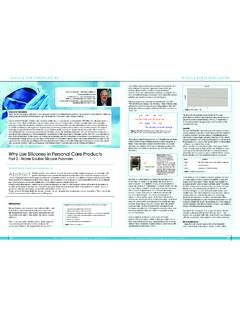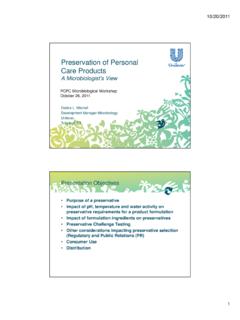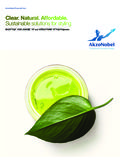Transcription of Silicone Emulsions and Surfactants – A Review
1 Editors Note: This edition of the Silicone Spectator is presenting a second general article on Silicone Chemistry. This one was written in 2000. While the paper was written a long while ago the contents are still topical today. We hope you enjoy. Silicone Emulsions and Surfactants A Review Anthony J. O'Lenick, Jr. Silicone Spectator . Siltech Inc. Box 715. Dacula, Ga. 30019 Dacula, Ga 30019. Originally Published: May 2000. Andrew O'Lenick Editor This Review , written in two parts, has the objective of supplying a working knowledge of the chemistry of Silicone compounds to the practicing chemist. It has been divided into two parts, the first dealing with basic chemistry of silicones, and the second dealing with Silicone based Surfactants .
2 This is the second part of the Review . Despite the fact that Silicone compounds have been around for over fifty years, the chemistry of these materials remains elusive to the average formulating chemist. This is indeed unfortunate, since the chemistry of silicon atom and resulting Silicone compounds is every bit as wide in scope and rich in content as the chemistry of the carbon atom and the resulting surfactant chemistry upon which it is based. Background Since most Silicone compounds are water insoluble, delivery these material in aqueous systems is from Emulsions . The use of Emulsions in many processes is acceptable, but Emulsions complicate other process and are completely ineffective in other processes.
3 Emulsions All emulsion products comprise (a) water typically at least 40%, (b) Silicone (typically 55%) and the remainder surfactant to make an emulsion . The fact that the Silicone is contained in an emulsion by necessity requires that the delivery be from a micelle. Since there is an equilibrium that exists between the Silicone on the substrate, like fabric, fiber, metal, rubber, hair or skin, and the Silicone in the emulsion , much of the Silicone ends up in the wash water. Not only is this very costly and an inefficient use of expensive raw materials, but there are real environmental concerns since the wash water ends up in the sewer. Emulsions are susceptible to freeze thaw instability and if detergents are added the emulsion will split due to shifting on the HLB.
4 These problems notwithstanding, Silicone Emulsions are used in many industrial applications. These include thread and textile lubricants, mold release agents for rubber and many others. The Emulsions tend to be specialized in their formulation to be ready to use, or just cut with water. Minimizing the additives, other than water, will allow for the formulation of the most stable products. Some more interesting applications areas for Emulsions include: Printer's Solution Oil based inks in lithographic printing use oil based inks. These inks contain a resin, which undergoes polymerization. Since the inks are not instantly cured, during the curing process a semi-solid ink occurs.
5 This period during which the ink cures is referred to as "setting". In ordinary oil-based inks, setting will usually require 15 to 30 minutes. Complete curing will usually require 3 to 10 hr. During the setting and drying of oil based inks the printed matter is subjected to smearing and destruction of the printed good. In addition, the substrate upon which the printing is done needs to be moved during the set and cure time, several problems can be encountered, including (a) ink smudge; (b) static electricity build-up and (c). paper tearing by the process of moving the paper through the high speed processing. Silicone Emulsions or Emulsions containing both Silicone oil and mineral oil are over- sprayed on the printed goods during the drying process right after printing1.
6 These materials, called printer's solution in the trade, allow for lubrication, anti-smudge and anti-static properties on printed goods. Tire Gloss The use of Silicone Emulsions on automotive tires, as dressings is well known. These products make up a set of commercially important products for consumer application. The products are Emulsions of an Silicone fluid in water. Each product is then specialized for specific market niches. Many products contain additives. These include polyols, sugars like sorbitol, and other additives like diethylene glycol and glycerin. Newer products include cleaning agents and Typically, the preservative composition is first used to thoroughly wet the surface.
7 After wetting the surface, sufficient time is then allowed for thorough penetration of the preservative into the surface layer of the material. It is believed that penetration occurs by capillary action whereby the molecules of the preservative composition, and especially the Silicone fluid, are drawn into the surface. There, the molecules can hook or wrap around the molecules of the material to be protected to physically attach themselves thereto. At least one additional re- wetting of the surface should then be made, followed by a period of penetration. Some products suggest at least three applications of the preservative to the surface to be protected for best results3.
8 Silicone Delivery Silicone delivered from Emulsions are delivered from micelles as shown;. AIR. hydrophobe hydrophilic WATER. surfactant Molecules at Air/Water Interface Micelle Formation Water Solution Silicone Delivery from Emulsions surfactant Oil Substrate Micelle Substrate Surface (drain) (delivered) (spots). In order to overcome the limitation on the use of Emulsions or Silicone oils per se, Silicone Surfactants have been developed that provide non-micelluar delivery to a variety of substrates. Silicone Surfactants A series of Surfactants which are based upon Silicone as a hydrophobe that contain other functional groups, similar to those seen in traditional Surfactants have been and continue to be developed.
9 In some instances, Silicone is incorporated into a surface-active agent, with a polyoxyalkylene portion of the molecule and or a hydrocarbon portion of the molecule. As will become clear, this results in several unique properties of the surfactant . Historically, Silicone compounds have been available as water insoluble oily materials. This has limited the number of Silicone compounds that the formulator could use in many applications. Knowing some of the limitations in the use of Silicone fluids, it is no surprise then that there is a desire to make more functional Silicone compounds. Silicone compounds that not only provide the desired softening, conditioning and treatment affects but are self-emulsifying.
10 The logical place to look for bridging technology is in the surfactant world. Surfactants are materials with an oil soluble group, generally fatty, and a water-soluble group. If one either includes a Silicone group as the hydrophobe, or includes a Silicone hydrophobe into the molecule a whole new world of formulator friendly compounds opens up. In order to make Silicone useful in aqueous systems, there are a variety of Emulsions available. The use of an emulsion makes the Silicone easier to handle, but there are issues related to emulsion stability that must be addressed. Specifically, the addition of Surfactants to the emulsion may shift the HLB and split the emulsion .











